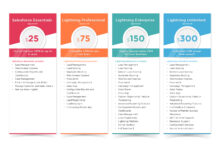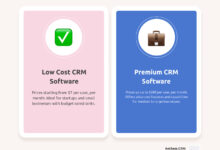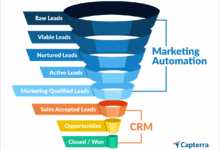CRM System Pricing: Understanding Costs And Strategies For Success
CRM system pricing is a crucial aspect that influences the adoption and success of customer relationship management solutions. From exploring various pricing models to uncovering hidden costs, this overview delves into the intricate world of CRM system pricing.
As organizations strive to optimize their customer interactions, understanding the nuances of pricing in CRM systems becomes paramount. Let’s navigate through the complexities of CRM system pricing to make informed decisions and drive business growth.
Overview of CRM System Pricing
When considering CRM system pricing, it is essential to understand the factors that influence the cost of implementing such a system. Pricing structures in CRM systems can vary widely depending on various elements, and having a clear understanding of these factors is crucial for making informed decisions.
Factors Influencing CRM System Pricing
- Features and Functionality: The range of features and functionalities offered by a CRM system can significantly impact its pricing. More advanced features and customization options often come at a higher cost.
- Deployment Model: Whether you choose an on-premise or cloud-based CRM solution can also affect pricing. Cloud-based solutions typically involve subscription-based pricing, while on-premise solutions may have higher upfront costs.
- Number of Users: The number of users who will be using the CRM system can influence pricing. Many CRM vendors charge per user, so the more users you have, the higher the overall cost.
- Integration Requirements: If you need the CRM system to integrate with other software applications or systems, this can impact pricing. Custom integrations or third-party integrations may incur additional costs.
- Training and Support: The level of training and support required for implementing and maintaining the CRM system can also play a role in pricing. Some vendors offer training packages or ongoing support services for an extra fee.
Importance of Understanding Pricing Structures in CRM Systems
Having a thorough understanding of pricing structures in CRM systems is crucial for budgeting and planning purposes. By knowing the various factors that can influence pricing, businesses can make informed decisions about which CRM system best fits their needs and budget. It also helps in avoiding unexpected costs and ensures that the chosen CRM system aligns with the organization’s goals and objectives.
Types of Pricing Models in CRM Systems
When it comes to CRM systems, there are different pricing models available for businesses to choose from based on their needs and budget. Let’s compare and contrast some of the common pricing models used in CRM systems.
Subscription-Based Pricing Model
Subscription-based pricing is one of the most popular models in CRM systems. In this model, customers pay a recurring fee at regular intervals, such as monthly or annually, to access the CRM software. This pricing model often includes updates, maintenance, and customer support as part of the package. The implications of a subscription-based model include predictable costs for businesses, scalability options, and continuous access to the latest features and updates without additional charges.
Pay-Per-User Pricing Model
The pay-per-user pricing model charges businesses based on the number of users accessing the CRM system. This model allows companies to pay for the exact usage and scale up or down as needed. The benefits of a pay-per-user pricing model include cost-effectiveness for small businesses with fewer users, flexibility to add or remove users without extra costs, and alignment of expenses with actual usage.
Factors Affecting CRM System Pricing
When it comes to determining the cost of CRM systems, several key factors come into play. These factors can significantly impact the overall pricing structure and customization options available to organizations.
Size of the Organization
The size of the organization plays a crucial role in influencing CRM system pricing. Larger organizations with a higher number of users and a more extensive customer database will typically require a more robust CRM system with advanced features and functionalities. As a result, the cost of implementing and maintaining the CRM system is likely to be higher for large organizations compared to smaller businesses. Additionally, larger organizations may need more customization and integration with existing systems, further affecting the pricing of the CRM solution.
Role of Customization
Customization is another significant factor that impacts CRM system pricing. Organizations often have unique requirements and specific workflows that need to be accommodated within the CRM system. The level of customization required can vary depending on the industry, business processes, and customer engagement strategies. As organizations seek more personalized and tailored CRM solutions, the cost of customization increases. Customization involves additional development work, integration with third-party applications, and ongoing maintenance, all of which contribute to the overall pricing of the CRM system. Organizations must carefully evaluate their customization needs and balance them with the associated costs to ensure they are getting the most value out of their CRM investment.
Pricing Strategies of CRM System Providers
CRM system providers utilize various pricing strategies to attract customers and maximize revenue. These strategies are tailored to different target market segments and competitive landscapes within the CRM system industry.
Tiered Pricing
- Providers offer different pricing tiers based on the features and functionalities included in each tier.
- Customers can choose a tier that aligns with their specific needs and budget constraints.
- Higher tiers typically offer more advanced features for larger businesses with complex CRM requirements.
Per-User Pricing
- Providers charge a fee for each user accessing the CRM system, making it scalable for businesses of all sizes.
- Per-user pricing allows companies to pay only for the number of employees using the CRM system.
- This model is popular among small and medium-sized businesses that want a cost-effective solution.
Usage-Based Pricing
- Customers are charged based on the amount of usage or data storage within the CRM system.
- Providers may offer different pricing tiers depending on the volume of data processed or stored by the customer.
- Usage-based pricing is flexible and allows businesses to scale their CRM costs according to their needs.
Competitive Pricing Landscape
- CRM system providers often engage in price wars to gain market share and attract new customers.
- Competitive pricing strategies may involve offering discounts, promotions, or value-added services to stay ahead of rivals.
- Providers must carefully balance pricing competitiveness with maintaining profitability and sustainable growth in the long run.
Negotiation Techniques for CRM System Pricing
When it comes to negotiating the pricing of CRM systems, there are several effective tactics that can help you secure a better deal. Leveraging competition, maintaining transparency, and being clear about your requirements are key elements in successful negotiations.
Effective Negotiation Tactics
- Do your research: Before entering into negotiations, make sure you have a clear understanding of the market rates and the features you require in a CRM system. This will help you negotiate from a position of knowledge.
- Highlight your unique needs: Communicate your specific needs and requirements to the CRM system provider. By emphasizing what sets you apart from other customers, you may be able to negotiate a customized pricing plan.
- Bundle services: Consider bundling additional services or features with the CRM system package. This can create additional value for the provider and may result in a more favorable pricing arrangement for you.
Leveraging Competition for Better Pricing
- Get quotes from multiple providers: By obtaining quotes from different CRM system providers, you can create competition among them. Use these quotes as leverage to negotiate better pricing or additional features.
- Highlight price disparities: If you receive a lower quote from one provider, use this information to negotiate with your preferred provider. Mentioning competitive pricing can often lead to price matching or discounts.
- Ask for price match guarantees: Some CRM system providers offer price match guarantees. If you find a lower price elsewhere, they will match it. Use this as a negotiation tactic to secure the best pricing.
Importance of Clarity and Transparency
- Be transparent about your budget: Clearly communicate your budget constraints to the CRM system provider. This can help them tailor a pricing plan that meets your financial requirements.
- Ask for detailed breakdowns: Request a detailed breakdown of the pricing structure to understand what you are paying for. This level of transparency can lead to more fruitful negotiations and prevent any hidden costs.
- Seek clarity on terms and conditions: Make sure you fully understand the terms and conditions of the pricing agreement. Clarity on renewal fees, upgrade costs, and cancellation policies is essential for a successful negotiation process.
Case Studies on CRM System Pricing
In this section, we will delve into real-world examples of organizations and their CRM system pricing strategies. We will analyze successful pricing implementations in CRM systems and discuss the challenges faced by companies in managing CRM system costs.
Case Study 1: Company A
- Company A, a global tech firm, implemented a value-based pricing model for their CRM system, aligning pricing with the benefits and ROI it provided to customers.
- By focusing on the value delivered rather than the product features, Company A was able to justify premium pricing and increase customer retention.
- However, the challenge faced by Company A was communicating the intangible benefits of their CRM system to potential clients and justifying the higher price point.
Case Study 2: Company B
- Company B, a medium-sized retail company, opted for a subscription-based pricing model for their CRM system, offering different tiers based on the scale of operations.
- By providing flexibility and scalability in pricing, Company B attracted a wide range of customers, from small businesses to large enterprises.
- The main challenge for Company B was ensuring that the pricing tiers were structured in a way that maximized revenue without alienating any customer segment.
Case Study 3: Company C
- Company C, a start-up in the healthcare industry, chose a usage-based pricing model for their CRM system, charging customers based on the number of interactions and data storage.
- This approach allowed Company C to cater to the specific needs of each customer and provide a cost-effective solution for businesses with fluctuating CRM usage.
- Nevertheless, the challenge for Company C was accurately predicting and managing costs as customer usage patterns varied.
Pricing Transparency in CRM Systems
In the CRM system industry, pricing transparency plays a crucial role in building trust and satisfaction among customers. When pricing information is clear and readily available, it helps customers make informed decisions and eliminates any doubts or uncertainties.
Significance of Pricing Transparency
- Transparent pricing builds credibility: When CRM system providers are open about their pricing models, customers are more likely to trust the company and feel confident in their investment.
- Enhances customer satisfaction: Clear pricing information helps customers understand the value they are receiving and prevents any surprises or hidden fees down the line.
- Attracts more customers: Businesses that are transparent about their pricing are perceived as honest and reliable, which can attract a larger customer base.
Impact on Customer Trust and Satisfaction
- Improves customer relationships: Transparent pricing fosters trust between the provider and the customer, leading to stronger and more long-lasting relationships.
- Reduces customer churn: When customers feel they are being treated fairly and honestly, they are more likely to stay loyal to the CRM system provider.
- Increases customer referrals: Satisfied customers who have experienced transparent pricing are more likely to recommend the CRM system to others, leading to organic growth.
Enhancing Transparency in Pricing Models
- Provide detailed pricing information: Clearly outline the costs involved, including any additional fees or charges that may apply.
- Offer customizable pricing options: Allow customers to tailor their pricing plans to suit their specific needs, promoting transparency and flexibility.
- Be upfront about discounts and promotions: Clearly communicate any discounts or special offers to customers, ensuring transparency in pricing.
Customization Costs in CRM System Pricing
Customization plays a crucial role in CRM system pricing, as it involves tailoring the system to meet the specific needs and requirements of a business.
Role of Customization in CRM System Pricing
- Customization involves modifying the CRM system to align with the unique processes and workflows of a company.
- This customization can include adding new features, integrating with other systems, or creating personalized dashboards for users.
- By customizing the CRM system, businesses can improve efficiency, enhance user adoption, and gain a competitive edge in the market.
Additional Costs Associated with Customizing CRM Systems
- Additional costs associated with customization include hiring developers or consultants to implement the changes, training users on the new features, and ongoing maintenance and support.
- Customization costs can also vary based on the complexity of the changes required and the level of expertise needed to carry out the customization.
- Businesses must consider these additional costs when budgeting for a CRM system to ensure they have the resources to support the customization process.
Impact of Customization on Overall Pricing Structure of CRM Systems
- Customization can significantly impact the overall pricing structure of CRM systems, as it adds to the initial cost of purchasing the system.
- Businesses may need to pay a one-time fee for customization services or opt for a subscription model that includes ongoing customization support.
- The extent of customization required can also affect the pricing, with more complex customizations typically costing more than simple modifications.
Future Trends in CRM System Pricing
In the constantly evolving landscape of CRM system pricing, several future trends are expected to shape the pricing models and strategies employed by CRM system providers. These trends are influenced by emerging technologies, market demands, and competitive pressures, which will likely impact how CRM systems are priced and offered to customers.
Subscription-Based Pricing Models
With the rise of subscription-based services in various industries, CRM system providers are likely to shift towards more flexible subscription models for their pricing. This could include tiered pricing plans based on the features and functionalities required by different customer segments, allowing for greater customization and scalability in pricing.
AI and Automation Impact
As artificial intelligence (AI) and automation technologies become more integrated into CRM systems, pricing may be influenced by the level of AI capabilities offered. Providers may introduce pricing tiers based on the extent of AI automation, with higher pricing for advanced AI functionalities that offer more personalized customer insights and predictive analytics.
Value-Based Pricing Strategies
In the future, CRM system providers may increasingly adopt value-based pricing strategies, where pricing is determined based on the perceived value and benefits delivered to customers. This approach focuses on aligning pricing with the specific value that customers derive from using the CRM system, rather than just the features and functionalities included in the package.
Industry-Specific Pricing Models
With the growing demand for industry-specific CRM solutions, providers may develop pricing models tailored to specific verticals or sectors. This could involve offering industry-specific modules or integrations at different price points, catering to the unique needs and requirements of businesses operating in different industries.
Blockchain Integration
The integration of blockchain technology into CRM systems could also impact pricing structures in the future. Blockchain-enabled CRM solutions offer enhanced security, transparency, and data integrity, which could lead to premium pricing models for businesses that prioritize data privacy and security in their CRM systems.
Epilogue
By unraveling the layers of CRM system pricing, businesses can make well-informed decisions that align with their goals and budget constraints. Navigating through the intricate landscape of pricing strategies and hidden costs empowers organizations to leverage CRM systems effectively for sustainable growth and customer satisfaction.


